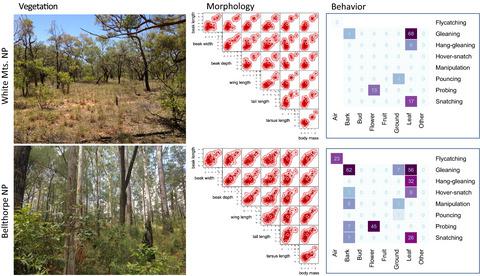当前位置:
X-MOL 学术
›
Ecol. Evol.
›
论文详情
Our official English website, www.x-mol.net, welcomes your
feedback! (Note: you will need to create a separate account there.)
Functional diversity of avian communities increases with canopy height: From individual behavior to continental-scale patterns
Ecology and Evolution ( IF 2.3 ) Pub Date : 2021-07-27 , DOI: 10.1002/ece3.7952 Vladimír Remeš 1, 2 , Eva Remešová 1 , Nicholas R Friedman 1, 3 , Beata Matysioková 1 , Lucia Rubáčová 1, 4
Ecology and Evolution ( IF 2.3 ) Pub Date : 2021-07-27 , DOI: 10.1002/ece3.7952 Vladimír Remeš 1, 2 , Eva Remešová 1 , Nicholas R Friedman 1, 3 , Beata Matysioková 1 , Lucia Rubáčová 1, 4
Affiliation

|
Vegetation complexity is an important predictor of animal species diversity. Specifically, taller vegetation should provide more potential ecological niches and thus harbor communities with higher species richness and functional diversity (FD). Resource use behavior is an especially important functional trait because it links species to their resource base with direct relevance to niche partitioning. However, it is unclear how exactly the diversity of resource use behavior changes with vegetation complexity. To address this question, we studied avian FD in relation to vegetation complexity along a continental-scale vegetation gradient. We quantified foraging behavior of passerine birds in terms of foraging method and substrate use at 21 sites (63 transects) spanning 3,000 km of woodlands and forests in Australia. We also quantified vegetation structure on 630 sampling points at the same sites. Additionally, we measured morphological traits for all 111 observed species in museum collections. We calculated individual-based, abundance-weighted FD in morphology and foraging behavior and related it to species richness and vegetation complexity (indexed by canopy height) using structural equation modeling, rarefaction analyses, and distance-based metrics. FD of morphology and foraging methods was best predicted by species richness. However, FD of substrate use was best predicted by canopy height (ranging 10–30 m), but only when substrates were categorized with fine resolution (17 categories), not when categorized coarsely (8 categories). These results suggest that, first, FD might increase with vegetation complexity independently of species richness, but whether it does so depends on the studied functional trait. Second, patterns found might be shaped by how finely we categorize functional traits. More complex vegetation provided larger "ecological space" with more resources, allowing the coexistence of more species with disproportionately more diverse foraging substrate use. We suggest that the latter pattern was driven by nonrandom accumulation of functionally distinct species with increasing canopy height.
中文翻译:

鸟类群落的功能多样性随着冠层高度的增加而增加:从个体行为到大陆规模模式
植被复杂性是动物物种多样性的重要预测指标。具体而言,较高的植被应提供更多潜在的生态位,从而孕育具有更高物种丰富度和功能多样性(FD)的群落。资源使用行为是一个特别重要的功能特征,因为它将物种与其资源基础联系起来,并与生态位划分直接相关。然而,目前尚不清楚资源利用行为的多样性究竟如何随着植被复杂性而变化。为了解决这个问题,我们研究了鸟类 FD 与沿大陆尺度植被梯度的植被复杂性的关系。我们在澳大利亚 3,000 公里的林地和森林中的 21 个地点(63 个样带)根据觅食方法和基质使用对雀形目鸟类的觅食行为进行了量化。我们还量化了同一地点 630 个采样点的植被结构。此外,我们还测量了博物馆藏品中所有 111 个观察到的物种的形态特征。我们计算了形态和觅食行为中基于个体的丰度加权 FD,并使用结构方程模型、稀疏分析和基于距离的指标将其与物种丰富度和植被复杂性(以冠层高度索引)相关联。形态和觅食方法的 FD 最好通过物种丰富度来预测。然而,基质使用的 FD 最好通过冠层高度(范围 10-30 m)来预测,但仅当基质以精细分辨率分类时(17 类),而不是粗分类时(8 类)。这些结果表明,首先,FD 可能会随着植被复杂性的增加而增加,与物种丰富度无关,但是否会增加取决于所研究的功能性状。 其次,发现的模式可能取决于我们对功能特征进行分类的精细程度。更复杂的植被提供了更大的“生态空间”和更多的资源,允许更多物种与更加多样化的觅食基质共存。我们认为后一种模式是由功能不同的物种随着冠层高度的增加而非随机积累所驱动的。
更新日期:2021-09-09
中文翻译:

鸟类群落的功能多样性随着冠层高度的增加而增加:从个体行为到大陆规模模式
植被复杂性是动物物种多样性的重要预测指标。具体而言,较高的植被应提供更多潜在的生态位,从而孕育具有更高物种丰富度和功能多样性(FD)的群落。资源使用行为是一个特别重要的功能特征,因为它将物种与其资源基础联系起来,并与生态位划分直接相关。然而,目前尚不清楚资源利用行为的多样性究竟如何随着植被复杂性而变化。为了解决这个问题,我们研究了鸟类 FD 与沿大陆尺度植被梯度的植被复杂性的关系。我们在澳大利亚 3,000 公里的林地和森林中的 21 个地点(63 个样带)根据觅食方法和基质使用对雀形目鸟类的觅食行为进行了量化。我们还量化了同一地点 630 个采样点的植被结构。此外,我们还测量了博物馆藏品中所有 111 个观察到的物种的形态特征。我们计算了形态和觅食行为中基于个体的丰度加权 FD,并使用结构方程模型、稀疏分析和基于距离的指标将其与物种丰富度和植被复杂性(以冠层高度索引)相关联。形态和觅食方法的 FD 最好通过物种丰富度来预测。然而,基质使用的 FD 最好通过冠层高度(范围 10-30 m)来预测,但仅当基质以精细分辨率分类时(17 类),而不是粗分类时(8 类)。这些结果表明,首先,FD 可能会随着植被复杂性的增加而增加,与物种丰富度无关,但是否会增加取决于所研究的功能性状。 其次,发现的模式可能取决于我们对功能特征进行分类的精细程度。更复杂的植被提供了更大的“生态空间”和更多的资源,允许更多物种与更加多样化的觅食基质共存。我们认为后一种模式是由功能不同的物种随着冠层高度的增加而非随机积累所驱动的。









































 京公网安备 11010802027423号
京公网安备 11010802027423号